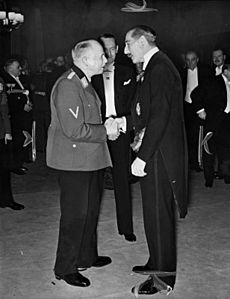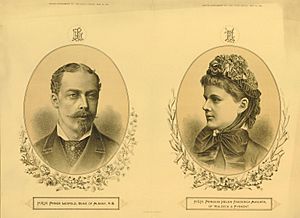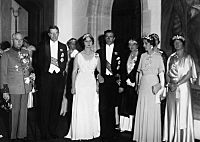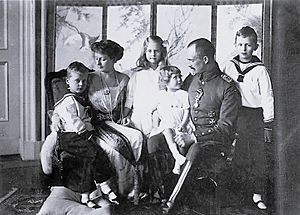Charles Edward, Duke of Saxe-Coburg and Gotha facts for kids
Quick facts for kids Charles Edward |
|||||
|---|---|---|---|---|---|
| Duke of Albany | |||||

The Duke c. 1905
|
|||||
| Duke of Saxe-Coburg and Gotha | |||||
| Reign | 30 July 1900 – 14 November 1918 | ||||
| Predecessor | Alfred | ||||
| Successor | Monarchy abolished | ||||
| Regent | Ernst, Hereditary Prince of Hohenlohe-Langenburg (1900–1905) | ||||
| Born | Prince Charles Edward, Duke of Albany 19 July 1884 Claremont House, Surrey, England |
||||
| Died | 6 March 1954 (aged 69) Coburg, West Germany (now Germany) |
||||
| Burial | near Schloss Callenberg, Germany | ||||
| Spouse |
Princess Victoria Adelaide of Schleswig-Holstein
(m. 1905) |
||||
| Issue |
|
||||
|
|||||
| House | Saxe-Coburg and Gotha | ||||
| Father | Prince Leopold, Duke of Albany | ||||
| Mother | Princess Helen of Waldeck and Pyrmont | ||||
| Military career | |||||
| Allegiance |
|
||||
| Service/ |
|||||
| Years of service | 1904–1918, 1933–1945 | ||||
| Rank |
|
||||
| Unit | 1st Foot Guards Sturmabteilung National Socialist Flyers Corps |
||||
| Battles/wars |
|
||||
Charles Edward (born Leopold Charles Edward George Albert; 19 July 1884 – 6 March 1954) was the last ruling duke of Saxe-Coburg and Gotha. This was a small state in Germany. He ruled from 1900 until 1918.
Charles Edward was a grandson of Queen Victoria of the United Kingdom. He was also a British prince and held British titles like Duke of Albany. He spent his early life in the United Kingdom. However, he moved to Germany as a teenager.
He unexpectedly became the Duke of Saxe-Coburg and Gotha in 1900. This happened because his cousin and uncle died young. He took full control of his role in 1905. He was known for being very loyal to the German Emperor. He also supported art, science, and local businesses.
During World War I, Charles Edward supported Germany. This made people in Britain dislike him. He eventually lost his British titles. In Germany, the end of the German Empire meant he lost his position as duke. After this, he became involved with a dangerous political group called the Nazis. After World War II, a special court fined him. He also lost land in the part of Germany controlled by the Soviet Union. Charles Edward died in 1954 in Coburg, Germany.
Contents
Growing Up in Britain
Prince Charles Edward was born at Claremont House in Surrey, England. His father was Prince Leopold, Duke of Albany. Leopold was the eighth child of Queen Victoria and Prince Albert. Charles Edward's mother was Princess Helen of Waldeck and Pyrmont.
His father, Prince Leopold, had died before Charles Edward was born. So, Charles Edward inherited his father's titles at birth. He was known as His Royal Highness the Duke of Albany. He was baptized at Claremont House in August 1884.
Charles Edward grew up in the United Kingdom for his first 15 years. He lived near Queen Victoria with his mother and sister, Alice. He went to two prep schools: Sandroyd School and Park Hill School. In 1898, he started at Eton College. He enjoyed his time at Eton very much.
Becoming Duke of Saxe-Coburg and Gotha
Why Did He Move to Germany?
In 1899, there was a decision about who would rule Saxe-Coburg and Gotha. The current Duke, Duke Alfred, was ill. His only son had died. The next in line was Prince Arthur, Duke of Connaught and Strathearn, Queen Victoria's third son. However, the German Emperor, Wilhelm II, did not want a British prince to rule a German state.
Prince Arthur's son, also named Arthur, was at Eton with Charles Edward. Young Arthur also gave up his claim to the Duchy. This made Charles Edward the next in line to become Duke. He was chosen to be the heir under family pressure.
Charles Edward moved to Germany at age fifteen with his mother and sister. He spoke very little German at the time. When his uncle Duke Alfred died in July 1900, Charles Edward became Duke at sixteen.
His Education and Life in Germany
Emperor Wilhelm II planned Charles Edward's education. He lived in Potsdam, near Berlin. Charles Edward attended a military school there. He also went to Bonn University. He became a member of a student club and joined a military regiment.
His uncle, King Edward VII of Britain, made him a Knight of the Garter in 1902. This was just before his 18th birthday. People in Coburg liked him. He was described as a "conscientious young man" who enjoyed arts and music. He also liked "sport and adventure."
Emperor Wilhelm II took a special interest in Charles Edward. He wanted Charles Edward to fit into German society. Charles Edward was even called "the Emperor's seventh son." Wilhelm II became like a father figure to him. He taught Charles Edward about German nationalism. However, Charles Edward often felt bullied by the Emperor.
How Did He Rule?
From 1900 to 1905, Charles Edward was too young to rule alone. Ernst, Hereditary Prince of Hohenlohe-Langenburg, ruled for him. Ernst followed Emperor Wilhelm II's strict advice. On his 21st birthday in July 1905, Charles Edward took full power.
He was loyal to the Emperor. He supported the court theaters in his two main towns, Gotha and Coburg. He was also interested in new technology like Zeppelins and airplanes. He supported the aircraft industry in Gotha. He spent his time between Gotha and Coburg. He especially liked Schloss Callenberg and worked on renovating Veste Coburg.
Charles Edward still felt connected to the United Kingdom. He visited often and stayed friends with the British royal family. However, World War I made things difficult. He decided to support Germany. He was in England when the war started. He told his sister he wanted to fight for Britain. But he felt he had to return to his German states. People there were starting to distrust him because he was English.
He broke ties with his British and Belgian relatives. But Germans still doubted his loyalty. Charles Edward had a lame leg, so he could not fight in battles. He served on the staff of a German army division. He visited the war fronts many times. He became more pro-German as the war went on.
In 1917, a law in Coburg stopped his British relatives from becoming Duke. That same year, German planes built in Gotha attacked London. In Britain, he was called a traitor. In 1915, King George V, his cousin, removed him from a special British order. Later, he lost his British titles.
After the Monarchy Ended
On November 9, 1918, during the German Revolution, Charles Edward was removed from power in Gotha. On November 14, he announced that he had "ceased to rule." He did not officially give up his throne. The next year, he lost his British titles. Some people in the UK still felt sorry for him. They knew he had been forced to become German as a teenager.
After 1919, his properties in Coburg were given to a foundation. This foundation still exists today. He kept Schloss Callenberg and some other properties. He also received money for his lost possessions.
After World War I, Charles Edward wanted the monarchy to return. He supported extreme right-wing political groups. He met Adolf Hitler in 1922. In 1929, he started giving money to the Nazi Party. He liked their focus on military strength and their opposition to communism.
Charles Edward was helpful to the Nazis before they gained power. He had many connections across Germany. In 1932, he helped create a group that connected other conservative groups with the Nazi Party. He also publicly asked people to vote for Hitler in the 1932 election.
A few months later, his daughter Sibylla married Prince Gustaf Adolf, Duke of Västerbotten. He was the son of the Crown Prince of Sweden. This meant Sibylla would likely become Queen of Sweden. Charles Edward used this wedding to show off his political ideas. He also wanted to improve his family's reputation.
In Nazi Germany
Charles Edward officially joined the Nazi Party in March 1933. He also became a high-ranking officer in the SA, a Nazi organization. He became president of a Nazi car association. This group provided vehicles for the German state.
From 1936 to 1945, he was a member of the German Parliament (Reichstag) for the Nazi Party. He was also president of the German Red Cross from 1933 to 1945. Under his leadership, the German Red Cross focused more on military matters. It also showed loyalty to the Nazi government.

The Nazi government used Charles Edward as an informal diplomat. In 1934, he visited Japan. He delivered Hitler's birthday greeting to Emperor Hirohito. In 1940, he traveled to the United States. He met President Roosevelt at the White House. In 1943, Hitler asked him to have the International Red Cross investigate a massacre.
He was important to the Nazis' efforts to gain support among British aristocrats. In 1936, he agreed to help Hitler by talking to people in Britain. He attended the funeral of his cousin George V in an SA uniform. He was president of the Anglo-German Fellowship, a group that promoted friendship between Britain and Germany. He tried to influence people who seemed to support Germany.
However, his efforts did not have much success. He did not understand that the people he grew up with now saw him as a foreigner. Charles Edward continued to support Nazism strongly during World War II. His three sons served in the German army. Two of his sons were killed in the war.
Later Life and Death
After World War II ended, American military authorities held Charles Edward from 1945 to 1946. His sister tried to get him released due to his health, but she was not successful. In 1950, a special court decided he was a "follower" of the Nazis but with "lesser guilt."
Charles Edward lost a lot of his property because of his involvement in World War II. The Soviet army took much of his family's property in Gotha. However, Coburg was in West Germany, so his family kept property there.
In 1946, his daughter Sibylla had a son, who would become Carl XVI Gustaf of Sweden. In 1947, Sibylla's husband died in a plane crash. In 1950, the King of Sweden died. At that point, Charles Edward's grandson became the Crown Prince of Sweden.
Charles Edward spent his last years living quietly. He was poor because of the fines he had to pay and the property he lost. In 1953, he watched the coronation of Elizabeth II, his cousin's granddaughter, in a local cinema.
Charles Edward died of cancer in Coburg on March 6, 1954, at age 69. He was buried near Schloss Callenberg.
Marriage and Children
Emperor Wilhelm II chose Princess Victoria Adelaide of Schleswig-Holstein to be Charles Edward's wife. She was his wife's niece. They married on October 11, 1905, and had five children. Victoria Adelaide was seen as the stronger partner in the marriage. Charles Edward often asked her for advice.
The family mostly spoke English at home. However, the children learned to speak German very well. Charles Edward's second son, Hubertus, was his favorite child. A newspaper described the children as "bright, happy children" who enjoyed sports and spent time outdoors. Later, it was said that Charles Edward ran his family "like a military unit." His children were sometimes a disappointment to him in their choices of partners. This was at a time when he wanted to use marriages to improve his family's reputation.
His Children
| Name | Birth | Death | Marriages |
|---|---|---|---|
| Johann Leopold, Hereditary Prince of Saxe-Coburg and Gotha | 2 August 1906 |
4 May 1972 |
(1) married Baroness Feodora von der Horst; divorced 1962; had children (2) married Maria Theresia Reindl; no children |
| Princess Sibylla of Saxe-Coburg and Gotha | 18 January 1908 |
28 November 1972 |
married Prince Gustaf Adolf of Sweden, and had children, including Carl XVI Gustaf of Sweden |
| Prince Hubertus of Saxe-Coburg and Gotha | 24 August 1909 |
26 November 1943 |
killed in action; no children |
| Princess Caroline Mathilde of Saxe-Coburg and Gotha | 22 June 1912 |
5 September 1983 |
married Friedrich Wolfgang Otto, Count of Castell-Rüdenhausen; divorced 1938; had children.
She married Flight Captain Max Schnirring; had children. She married Karl Otto Andree; divorced 1949 |
| Friedrich Josias, Prince of Saxe-Coburg and Gotha | 29 November 1918 |
23 January 1998 |
(1) married Countess Viktoria-Luise of Solms-Baruth; divorced 1947; had children (2) married Denyse Henrietta von Muralt; divorced 1964; had children (3) married Katrin Bremme; no children |
Images for kids
-
Charles Edward visiting a hospital in German-occupied Prague (1942)













